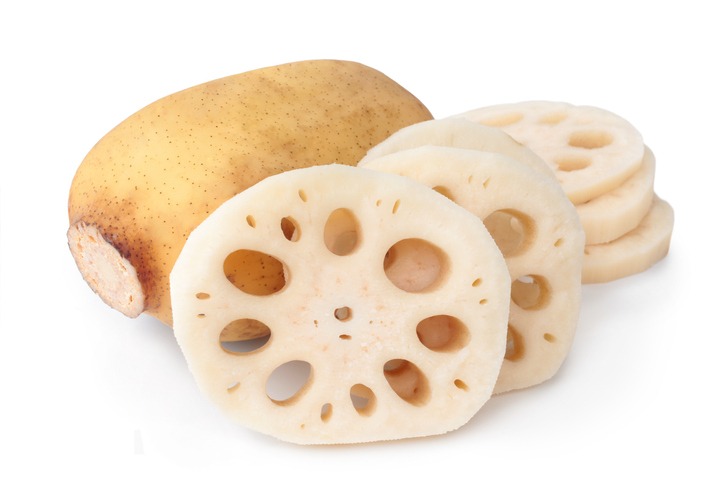Lotus Root Juice: Mild, Crunchy, and Rich in Fiber and Vitamins

Lotus root juice is a delightful enhancement to your diet, offering a mild flavor with a invigorating crunch. It's rich in fiber, promoting digestive health and regularity, and packed with vitamin C to enhance your immune system and skin health. With 218mg of potassium in each serving, it supports heart health and regulates blood pressure. You can enjoy it in smoothies, soups, or as a base for marinades. While making it, use fresh roots for the best taste and nutrition. A fascinating mix of culinary and health benefits await as you investigate more about this versatile juice.
Nutritional Benefits of Lotus Root Juice
Exploring the nutritional benefits of lotus root juice reveals why it's a fantastic supplement to your diet. This mild and crunchy root boasts impressive nutritional value. It's low in calories, with just 39.6 calories per half-cup serving, making it ideal for weight management. Its rich dietary fiber content, about 1.9g per serving, aids in promoting digestive health and regularity.
One of the standout features of lotus root juice is its high vitamin C content. With 16.4mg per serving, it supports your immune function and contributes to healthy, glowing skin. The juice is also an excellent source of important minerals like potassium, offering 218mg per serving. This mineral helps regulate blood pressure and promotes heart health, making it a fantastic choice for cardiovascular support.
Moreover, lotus root juice scores a low glycemic index of 33, which means it's a low GI food. This makes it beneficial for blood sugar control, especially if you're managing diabetes or insulin sensitivity. In addition, its antioxidant content improves its nutritional profile, helping to combat oxidative stress. Incorporating lotus root juice into your diet is a delicious way to elevate general health.
Health Advantages
Often overlooked, lotus root juice offers a multitude of health advantages that can improve your well-being. Packed with vitamin C, lotus root juice elevates your immune system and augments skin health by supporting collagen synthesis. You'll find that it's not just about the vitamins; the high dietary fiber content is vital for aiding digestion and regulating blood sugar levels, which is significant for weight management. This makes lotus root juice a beneficial supplement to your daily routine.
Furthermore, lotus root juice is a powerhouse of antioxidants that combat oxidative stress. These antioxidants help reduce inflammation, promoting general health. Its potassium content is another health benefit, contributing to cardiovascular health by regulating blood pressure and lowering the risk of hypertension. With all these benefits, lotus root juice supports nutrient absorption and guarantees your digestive system functions smoothly.
Consider these key health benefits of lotus root juice:
- Elevates immune function with vitamin C, improving skin health.
- Aids digestion and supports weight management due to high dietary fiber.
- Augments cardiovascular health by regulating blood pressure with potassium.
- Reduces inflammation through powerful antioxidants, supporting general well-being.
Incorporating lotus root juice into your diet can truly improve your health path.
Culinary Uses

Lotus root juice isn't just a powerhouse of health benefits; it also shines in the culinary world with its versatility and unique flavor. You can raise your culinary creations by incorporating lotus root juice, which is rich in fiber and vitamin C content, into a variety of dishes. Start by blending it into smoothies or health drinks for an added nutritional enhancement that supports digestion and immunity.
In salads, lotus root juice makes an excellent base for dressings, offering a rejuvenating and slightly sweet profile that complements greens and vegetables while increasing dietary fiber intake. For savory options, use it in marinades for meats or tofu. Its subtle sweetness improves the comprehensive texture and flavor, making your dishes more succulent and flavorful.
When it comes to warming soups and stews, adding lotus root juice improves the broth with its mild flavor, providing an extra layer of nutrients. For those with a sweet tooth, this versatile juice can be incorporated into desserts like puddings or jellies. You'll enjoy a nutritious twist on traditional treats, ensuring you don't sacrifice taste while elevating your dessert's health quotient. With its adaptability, lotus root juice can transform your culinary endeavors delightfully.
Preparing Lotus Root Juice
To get started with preparing lotus root juice, you'll initially need to choose fresh and firm lotus roots. Begin by peeling and slicing them into thin pieces to enhance juicing efficiency. Once sliced, soak the lotus root in acidulated water—using vinegar or lemon juice—for about 10-15 minutes. This step helps prevent browning and keeps the lively color intact, ensuring your juice looks as good as it tastes.
Next, follow these simple steps to prepare your juice:
- Blend: Combine the soaked slices with water and blend until smooth.
- Extract the juice: Strain the blended mixture through a fine mesh sieve or cheesecloth, leaving the pulp behind.
- Enhance flavor: For a more exciting taste and better nutritional profile, mix your lotus root juice with fruits or vegetables like apple or cucumber.
- Consume immediately: Drink the fresh juice right away for ideal freshness and to preserve its vitamin C content.
Potential Allergies and Risks

While lotus root juice offers a revitalizing and nutritious beverage option, it's vital to be aware of potential allergies and risks associated with its consumption. Some individuals may experience allergic reactions, even though they are uncommon. Symptoms like hives, wheezing, or tongue swelling can occur, particularly if you have a history of food allergies or sensitivities to other members of the Nelumbonaceae family. In such cases, exercising caution when trying lotus root juice is wise.
Additionally, the high oxalate content in lotus root could pose a risk for those prone to kidney stones. Consuming lotus root juice in moderation helps mitigate this concern. Digestive discomfort is another potential issue; raw lotus root, including its juice, might not sit well with everyone. Opting for cooked lotus root can improve digestibility and safety.
For individuals with diabetes, it's important to consult a healthcare provider before adding lotus root juice to your diet. This juice can lower blood sugar levels, potentially leading to hypoglycemia. Being informed about these risks guarantees you enjoy lotus root juice safely while maximizing its health benefits. Always prioritize moderation in consumption and consider your personal health needs.
Storage Tips
Storing lotus root properly guarantees you maintain its freshness and flavor. Fresh lotus root should be kept in a cool, dry place and can last 1-2 weeks when unwashed. For peeled and sliced lotus root, it's crucial to store it in an airtight container. This helps maintain freshness and prevents it from drying out. When you need to extend shelf life, wrap the fresh lotus root in a damp cloth or plastic before refrigerating. This technique locks in moisture and supports ideal taste.
Soaking the exposed parts of the lotus root in acidulated water, such as with vinegar or lemon juice, helps maintain its color and reduce bitterness. Always remember to wash thoroughly before consumption to remove any dirt and contaminants. Cooked lotus root should be refrigerated and consumed within 3 days to achieve the best flavor and texture. Here are some storage tips to help you:
- Wrap fresh lotus root in a damp cloth or plastic for refrigeration.
- Use an airtight container for peeled and sliced lotus root.
- Soak exposed parts in acidulated water to maintain color.
- Consume cooked lotus root within 3 days for ideal taste.
Cultural Significance
Embodying purity and enlightenment in Eastern philosophies, lotus root holds a profound cultural significance across Asia. You'll find its presence in numerous Asian traditions where it symbolizes prosperity, health, and abundance. During seasonal events and community gatherings, the lotus root becomes a focal point, celebrating its role in promoting well-being and unity among people. The cultural importance of lotus root extends beyond symbolism, reaching into culinary traditions. Its unique texture and flavor make it a staple in many households, where it's used to create dishes that are both delicious and meaningful.
In addition to its culinary uses, lotus root is cherished for its health benefits. It plays a crucial role in traditional medicine, known for promoting qi circulation and relieving inflammation, which further improves its status in cultural practices. By incorporating lotus root into your diet, you're not just savoring a flavorful ingredient but also embracing a piece of rich cultural heritage. As you investigate its uses, you'll realize how deeply embedded it is in the traditions and lifestyles of many Asian communities, reminding you of the interconnectedness of health, culinary arts, and cultural enlightenment.




